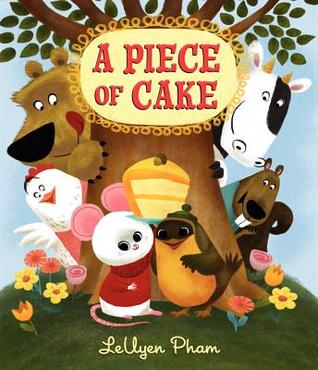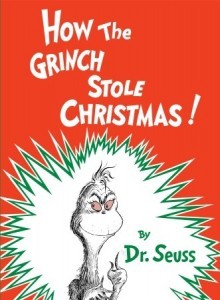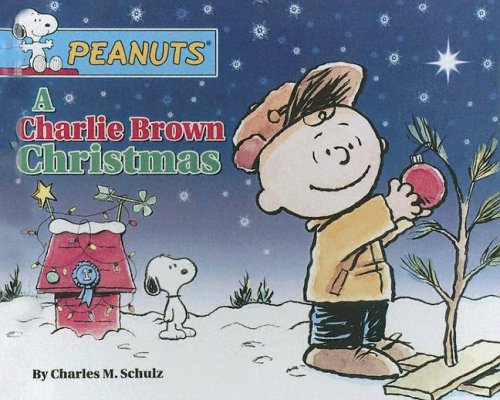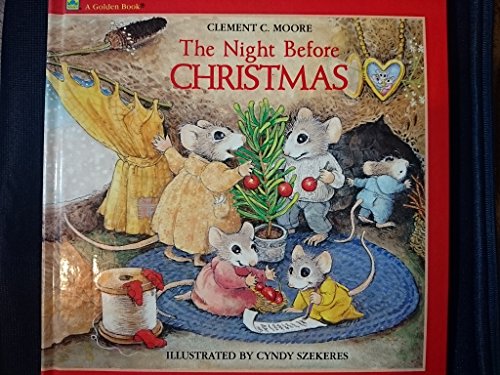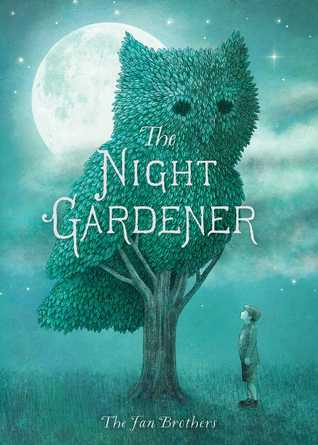Hello Bloggers! It’s Friday, December 2.
Since we focused our energy on Mock Caldecott classroom activities this week, I scoured the library for Caldecott award winning books that I had not read yet and checked out a stack. I did find one book available in the North Platte Library which was on a few of the possible nominee lists for the Caldecott 2017…..”Ideas Are All Around” by Philip C. Stead. The rest of my findings this week are winners of years-past Caldecott awards.
- “Ideas Are All Around” by Philip C. Stead. This book has been hailed a possible nominee of the 2017 Caldecott award. I loved the mixture of illustrations and photographs throughout this book! The story is told by a man whose job is to write stories but his dog would rather they go on a walk. The man realizes that ideas to write and talk about are really everywhere, no matter where he goes and what he see’s when walking his dog, he gains little ideas to chat about with his neighbor and to write about. It was a cool read and I absolutely loved the pictures throughout.

2. “Interrupting Chicken” by David Ezra Stein. This book has been on my wishlist for a few weeks due to the reviews I’ve read by fellow classmates. It gained the Caldecott award in 2011. This adorable story is about a papa telling chicken bedtime stories but every time papa gets to the scary part of the story, chicken interrupts the story, warns the characters and papa moves on to another story, in hopes he can find one that chicken won’t interrupt. Papa reads through Hansel and Gretel, Little Red Riding Hood and Chicken Little and during each story, right when it was about to get scary or interesting, chicken interrupted and finished the story early. When chicken begs for one more, Papa tells her that instead, Chicken should tell him a story (in hopes Chicken won’t interrupt herself). Chicken begins to tell papa a story and immediately, papa falls asleep. Chicken can’t believe it, she tells papa goodnight through his snoring and crawls into be with him and falls asleep herself. Adorable, especially for parents who have little chickens at home who always want one more bedtime story!

3. “Flotsam” by David Wiesner. This book won the Caldecott award in 2007. Flotsam is a true picture book, there is not one word but there are many many wonderful pictures. Flotsam means ocean debris that was not intentionally thrown overboard. In this story, a boy on a beach runs across an old aquatic camera on a beach. He finds that it still has it’s roll of film so he takes it to be developed and see’s magical pictures of fish and octopus, sea turtles and blow fish, star fish and then more believable pictures of a girl holding pictures that look like they’re from long ago. The boy studies the pictures and finds other pictures of children holding up pictures from long ago, each dating back a little further. He realizes he has pictures of pictures of children from 10, 25, 40, 55 and 70 years ago on the pictures he’s developed. He decides to carry on the tradition of this Flotsam and takes pictures of himself holding each of the pictures he found on the film. He then threw the camera back into the ocean to be found by another child another day. Now, since the camera had been intentionally thrown overboard, it is really “jetsam”. This was a really cool story that wove history into it’s pictures and it was definitely well-told with just pictures!

4. “My Grandfather’s Coat” retold by Jim Aylesworth. This story is a Nebraska Golden Sower nominee for 2016. I did not find it on any of the Caldecott nomination lists but thought I’d add it to my reading this week since it is a book that fits into my personal reading challenge for this class. This story tells about a man who came to America and became a tailor. He worked very hard and made himself a coat. Through the years, the coat became worn and eventually, he made it into a jacket. Through the years, the jacket became worn so he converted it into a vest. Years later, the vest became worn so he turned it into a tie. Eventually, even the tie became worn out so he turned it into a little mouse for his grandson to play with with his kittens. Eventually, the mouse became worn out and the little boy was sad. His grandfather told him that nothing had been wasted and he was right. That night, a mouse found the scraps of the toy mouse and took it behind the walls to make it into her own nest and eventually raised her babies in that nest. Eventually, all that was left of that coat was the story, and a dear story of the passing of time, the development of families and the hard work of a tailor were passed down with it.

5. “Joseph Had a Little Overcoat” by Simms Taback. This story won the Caldecott award in 2000. This story reminded me in so many ways, of “My Grandfathers Coat” by Jim Aylesworth. Joseph had an overcoat and when it got old and worn, he made it into a jacket. When that jacket got old and worn, he made it into a vest. When the vest got old an worn, he made it into a scarf and once that scarf got old and worn, he made it into a neck tie. When the neck tie got old an worn, he made a handkerchief out of it and when that handkerchief got old and worn, he made a button out of it. One day he lost that button and thought he had nothing but sat down and wrote the story about the transformation of the overcoat and realized that he could make something out of nothing. I really liked this story and especially liked the cut outs on the pages which foreshadowed what Joseph might make next.

6. “Time of Wonder” by Joseph McCloskey. This story won the Caldecott award in 1958. The book has some wonderful illustrations which almost look like watercolors. The story tells the tale of a summer spend on a coastal island, the animals one might encounter and the activities that one might enjoy when vacationing on the East Coast of the United States. The story is told through the eyes and experiences of a child who is part of a family who lives in a summer home. During the stay, a storm starts to brew and the family hunkers down with extra groceries to wait out the storm. Once the storm is over, the family can discover places and things that have never been seen before due to the storm. Eventually, the summer has come to an end and it’s time for the family to go back to their inland home. The story tells all about the different times of wonder that the child encounters throughout their summer vacation and the tale is truly enchanting.

7. “Winnie – The True Story of the Bear Who Inspired Winnie-the-Pooh” by Sally M. Walker. This book is a Nebraska Golden Sower Nominee for 2016 and was such a joy to read! This story tells us about a veterinarian named Harry, who was also a soldier in World War I. At a train station one day, a man was selling a baby black bear and the veterinarian/soldier just knew he had to save her and give her a good home. The bear traveled to military training with the soldier in Quebec and then overseas to be closer to military action in England. When the soldier was called to France to doctor injured horses, the soldier worked out a deal with the London Zoo to care for Winnie while he was at war. Winnie was well taken care of at the London Zoo; she made friends with other bears and was able to play with visiting children. Eventually, enough time had passed that the soldier determined Winnie would be better off living out her life at the Zoo, where she was most comfortable. One day, when Winnie was 11, Winnie was introduced to a child named Christopher Robin, whose father was a well-known author. This friendship between Christopher Robin and Winnie inspired the future stories about Winnie-The-Pooh. This was an amazing summary of the life of Winnie, the bear who inspired Winnie the Pooh and included amazing illustrations and photography of the original soldier and bear.

8. “Black and White” by David Macaulay. This book won the Caldecott Award in 1991. The book is slightly confusing, without the slightly since it has 4 story lines going at once throughout the book – but in the authors defense, he does warn you about this on the first page. One of the story lines is about a family who dresses up in newspapers for a jolly night at home. Another story line is all about a herd of Holstein cows. Another story line, the main one I believe, is about a boy who is on a train ride home to see his parents. On his way home, the train must stop for a herd of Holsteins and also along the way, he thinks he see’s snow but it’s really pieces of newspaper that are flitting through the air like snowflakes. The last story line is about a group of people waiting for a train at a train station. The train they’re waiting on has been delayed due to Holsteins! It was a cute story, but confusing to follow – I kept having to restart to make sure I didn’t miss anything.

9. “Finders Keepers” by Will Limpkind and Nicolas Mordvinoff. This book won the Caldecott Award in 1952. This story is a good one, especially since my 4-year-old has begun to use this term on a daily basis whenever he finds something around the house he thinks he’d like to call his. The story was about two dogs, one who found a bone and one who touched it first. They argued and argued about whose bone it truly was so they went in search of someone who might help them decide. Everyone they ask for help seems to only care about themselves and ends up not being any help to the dogs and their dilemma. Finally, the pair run into a bigger dog who tries to take their bone. The two dogs fight him off and save their bone and realize it’s better to share the bone than to worry about finders keepers. This is an adorable book and the moral is that sharing is the way to solve many problems.

10. “Owl Moon” by Jane Yolen. This book won the Caldecott Award in 1988. This is a beautiful story about a little girl who finally gets to go out on a winter night with her pa to go owling. The daughter and father walked and walked on a cold moon-lit night and called for the Great Horned Owl every now and again. Finally, when they reached a clearing in the dark woods, Pa called out and an owl answered back. The two got a very close look at the owl before it silently flew away. They returned home victorious, having successfully called an owl. In the authors notes, she dedicated the story to her husband who had taken their children owling and to her grand daughter for the time when she’s old enough to go owling. It was a very heart-warming story.

11. “Sam, Bangs & Moonshine” by Evaline Ness. This book won the Caldecott award in 1967. This story is about Sam, a fisherman’s daughter, who could tell amazing stories. Although Sam claims to have many exotic pets, the one she has for sure is her faithful black cat named Bangs. She lays on a rug and pretends it’s a chariot drawn by dragons and reads things that take her to far away lands. When she talks to anyone, she tells stories that are far from true. Her father calls her kind of stories, moonshine. One day, he asks her to talk REAL instead of MOONSHINE since moonshine talk means trouble but Sam was not sure what he meant. Almost every day, a boy named Thomas comes to Sam’s home hoping to see the kangaroo that Sam claims lives with her. One day, Sam tells Thomas to run out on a narrow rock path to an island where she’s sure the kangaroo has gone to visit her mermaid mother. The tide is coming in and rain is starting to fall and Sam realizes that Bangs and Thomas are in danger on the island and tells her father of their danger as soon as he returns from fishing. Her father rushed out and saved Thomas but there was no sign of Bangs. Before she went to bed that night, her father told her to think long and hard about real and moonshine. Sam realized that her moonshine tales might have killed Thomas and Bangs is still missing. She also realized that real is no mermaid mother or kangaroos and that real is just her father and Bangs and now, Bangs might never return. Just then, Bangs appeared in the window! Sam vowed to always know the difference between real and moonshine. The next day, her father brought her a gerbil from one of the African fishing ships. Sam decided it was very similar to a kangaroo and that it was the perfect gift for Thomas. She visited the recovering Thomas and gifted him the gerbil and they named it moonshine. This was an adorable story with a wonderful lesson for children about the difference between imagination and reality.

12. “Song of the Swallows” by Leo Politi. This book won the Caldecott Award in 1950. This lovely little story takes place in the village of Capistrano near in old Mission. Juan is a boy who visits the mission often since he loves it’s beauty. He especially likes the birds that visit the mission since they can be undisturbed. Humming birds, white pigeons, sparrows, swallows and other birds frequent the mission garden. Juan’s favorite type of bird in the garden were the swallows which came in the spring on Saint Joseph’s Day and left late in the summer. Juan loved to watch the swallows build their nests and watch the parents teach their babies how to fly. One year, Juan decided he wanted to guild his own garden in front of his house in hopes the swallows might come there to next when they return in the spring. When spring eventually came, Juan was exuberant to see that swallows were flitting around his yard, they had come there to nest! The swallows were his dear friends and he was so happy to have them so close to his home!

13. “The Little House” by Virginia Lee Burton. This book won the Caldecott Award in 1943. This is a story about a little house that at on a hill, surrounded by a peaceful countryside. The man who built it thought it should never be sold and that his great-great-grandchildren’s great-great-grandchildren would eventually live there. As time went by, roads were build into that countryside and homes began to populate the hillsides. Automobiles moved back and forth and the countryside had become a very populated and busy place. Eventually, more roads were made and the countryside was divided into lots and huge apartment houses surrounded the house. Trolley tracks and eventually elevated trains were installed in front of the little house and it was not so little and peaceful anymore. Eventually, the apartments were all torn down and the little house found itself surrounded by sky scrapers, huge truck traffic and lots of coming and going. The little house couldn’t even see the night sky or the daylight anymore. The little house looked sad and lonely, her windows were broken and she looked shabby, but she had good bones under her shabby appearance. One day, the great-great-granddaughter of the man who originally built the little house walked by the little house, recognized it and realized it was the very same house from her family’s past. She called some movers and she had the house moved out into the country. The little house was happy and looked amazing again as it was able to see the sunrise and set as well as the night sky.

14. “Ox-Cart Man” by Donald Hall. This book won the Caldecott Award in 1980. This story is about a time of year when the father of the family loads all of the things a family has made, grown, and collected throughout the year and takes it to the town of Portsmouth in his ox-drawn wagon. He takes all of the items to a market and sells the items, he even sells the cart, the ox and it’s harness. With the money he made on the sale, he purchased an iron kettle for the family kitchen, embroidery needles for his daughter, a knife for his son, peppermint candies for his wife, and he walked home with money in his pockets. When he arrived home, he gave the items to his family members and sat in front of the fire stitching a new harness for the young ox in the barn. As the winter went by, the entire process started again so the man could make his trip to town again next year.

15. “The Big Snow” by Berta and Elmer Hader. This book won the Caldecott Award in 1949. This story is about the coming cold winter days and how animals prepare for winter. It shows us how rabbits watch the geese fly south and they know it’s time to eat plenty so they can grow a winter coat. The groundhogs and raccoons prepare for a long winters nap, the chipmunk stores seeds and nuts in her home under the rock pile, and the blue jays prepare to fly south. The cardinals, sparrows, pheasants, black crows, meadow mice, skunks, deer and robins prepare for winter by watching it come, they love winter. The brown wood rat, the squirrels and the white-footed wood mouse busily story food in their nests. As the days grow shorter and the first snow falls, animals go about their business until spring wakens the countryside and new babies in nests and above ground began to push their parents to provide food. The snow does not recede so people put out hay, seeds and nuts and bread crumbs in their yards and the animals come from far and wide to nurture themselves. The illustrations were amazing in this story and it’s hard for the reader not to learn something new about the animals in the world around us.

16. “White Snow, Bright Snow” by Alvin Tresselt. This book won the Caldecott Award in 1948. This story is about a snow story that is slowly beginning with white silent flakes that sift down from the sky. People of all occupations prepare for the snow in their own way and children looked forward to a snow day! As silently as it came, the snow eventually melted the snow away, the children’s snowmen melted and robins heralded the coming of spring.

17. “Madeline’s Rescue” by Ludwig Bemelmans. This book won the Caldecott Award in 1954. This story is about a girl named Madeline who lives in a boarding school in Paris with eleven other girls who leave for school in two lines every morning. One morning, Madeline slipped and fell into the water and would have drown but a dog saved her. The dog was then taken in by the girls and it slept in their room, went to school with them and ate meals with them, they named it Genevieve. An inspection was done of the boarding school one day and the trustees insisted that the dog must go. They were forced to kick the dog to the streets but soon after the trustees left, they set out to find Genevieve. The searched but could not find her and everyone went to bed disheartened. That night, Genevieve came home and was waiting outside. The school mistress let her in and everyone was happy again, but the girls fought over who would sleep with her that night. One night, Genevieve had pups and suddenly, there were enough dogs for each girl to cuddle with!

18. “Song and Dance Man” by Karen Ackerman. This book won the Caldecott Award in 1989. This story is about a grandpa who had once danced on the vaudeville stage. In this darling story, a grandfather tells stories to his grandchildren about days when people didn’t use TV’s for entertainment and instead, they had songs and dance to entertain. He takes his grandchildren to the attic and digs out his old tap shoes and outfits and puts on shows for his grandchildren every time they come to visit. The children love the antics and giggle as he pulls silver dollars from their ears and git the hiccups from laughing so much. When the show is over, they put the costumes back in the trunk and head downstairs, looking forward to the next time they visit so they can see their grandpa, the song and dance man, in action.

19. “Golem” by David Wisniewski. This book won the Caldecott Award in 1997. This story takes place in Prague at a time when fierce hatred is brewing among people of all religions. Angry mobs are treating Jews horribly so the chief Rabbi goes to fast and pray for the deliverance of his people. The rabbi, with the help of his son in law, created a great living thing out of clay named Golem. Golem, with “truth” written on his forehead, went forward to protect the Jews. He was to be called Joseph and be a servant in the synagogue by day and be the supernatural Golem who protected Jews by night. Once all of the people who were doing the Jews wrong had been stopped, the rabbi turned Golem into clay again, but knows that if ever again the Jews are in danger, Golem could come to their rescue. I was not a big fan of this story – I hated how the master (the rabbi) killed Golem even though he begged to live. It was just too dark for me.

